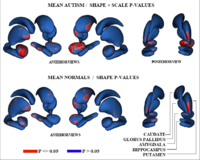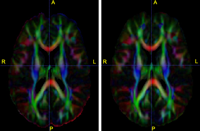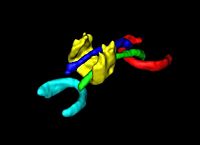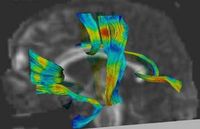Difference between revisions of "Algorithm:Utah"
| Line 13: | Line 13: | ||
== [[Projects:ParticlesForShapesAndComplexes|Adaptive, Particle-Based Sampling for Shapes and Complexes]] == | == [[Projects:ParticlesForShapesAndComplexes|Adaptive, Particle-Based Sampling for Shapes and Complexes]] == | ||
| − | + | This research is a new method for constructing compact statistical point-based models of ensembles of similar shapes that does not rely on any specific surface parameterization. The method requires very little preprocessing or parameter tuning, and is applicable to a wider range of problems than existing methods, including nonmanifold surfaces and objects of arbitrary topology. [[Projects:ParticlesForShapesAndComplexes|More...]] | |
| − | <font color="red">'''New: '''</font> | + | <font color="red">'''New: '''</font> |
|- | |- | ||
Revision as of 22:46, 9 December 2007
Home < Algorithm:UtahBack to NA-MIC Algorithms
Overview of Utah Algorithms
A brief overview of the Utah's algorithms goes here. This should not be much longer than a paragraph. Remember that people visiting your site want to be able to understand very quickly what you're all about and then they want to jump into your site's projects. The projects below are organized into a two column table: the left column is for representative images and the right column is for project overviews. The number of rows corresponds to the number of projects at your site. Put the most interesting and relevant projects at the top of the table. You do not need to organize the table according to subject matter (i.e. do not group all segmentation projects together and all DWI projects together).
Utah Projects

|
Adaptive, Particle-Based Sampling for Shapes and ComplexesThis research is a new method for constructing compact statistical point-based models of ensembles of similar shapes that does not rely on any specific surface parameterization. The method requires very little preprocessing or parameter tuning, and is applicable to a wider range of problems than existing methods, including nonmanifold surfaces and objects of arbitrary topology. More... New: |

|
Diffusion Tensor Image Processing ToolsWe implement the diffusion weighted image (DWI) registration model from the paper of G.K.Rohde et al. Patient head motion and eddy currents distortion cause artifacts in maps of diffusion parameters computer from DWI. This model corrects these two distortions at the same time including brightness correction. |

|
DTI Volumetric White Matter ConnectivityHere we write a very brief description of Project 1. Notice a representative image is chosen from the project and places in the left column. More... New: Here we give something new and exciting about the project. The most recent publication on this project is very appropriate for this slot. |

|
Tissue Classification with Neighborhood StatisticsHere we write a very brief description of Project 3. Notice a representative image is chosen from the project and places in the left column. More... New: Here we give something new and exciting about the project. The most recent publication on this project is very appropriate for this slot. |